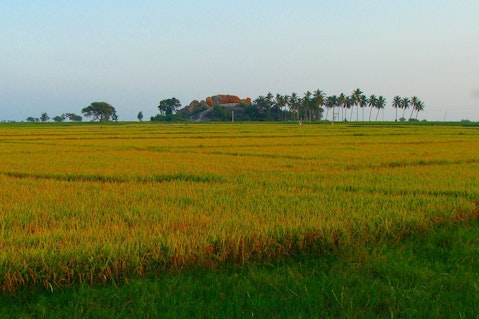In this article, we’ll discuss the top 20 rice producing countries in the world. If you want to skip the details, move straight to Top 10 Rice Producing Countries In the World.
Over 90% of the world’s rice crop is harvested and consumed in the Asia-Pacific Region, with China and India claiming over 50% of the production. These countries’ dominion is attributable to their vast paddy fields, substantial rural labor force, and favorable climates, all of which provide ideal conditions for paddy cultivation.
Rice is a tropical and subtropical crop that requires water and warmth. The existence of fertile delta regions, such as the Yangtze in China, the Ganges-Brahmaputra in India-Bangladesh, and the Mekong in Vietnam, provide the alluvial soil conducive for rice farming.
Likewise, despite grappling with climate change and inconsistent weather patterns, Indonesia and Bangladesh have consistently ranked among the top five global producers due to innovative farming techniques and the development of climate-resilient rice strains. Japan, although not a leading producer, has achieved a stable market share for cultivating premium, short-grain rice like Koshihikari and Sasanishiki. Beyond Asia, the United States, Brazil, and Egypt are considerable names in global rice production, even with challenges like labor shortages, water scarcity, and land limitations.
However, the Asia-Pacific Region, home to nearly 60% of the world’s population, also sees a population growth of 0.96% per annum. Consequently, the rice self-sufficiency experienced by many countries is dwindling, and climate change is adding to it.
For instance, China is a leading rice importer even when its production is among the highest, owing to the dense population and increased per capita rice consumption (nearly 221 pounds per year). The global per capita rice consumption is close to 54 kgs per year, which calls for better grain distribution amongst rice exporter and importer countries.
How Does Rice Production Impact Food Insecurity?
COVID-19 impacted more than four years of progress on poverty eradication and led approximately 93 million more people into extreme poverty in 2020. Moreover, in 2020, 2.4 billion people (above 30% of the population) were moderately or severely food-insecure, thereby having restricted access to food.
The role of rice crops, as a cheap and nutrient-rich food source, is instrumental to combating this issue. With the world’s population projected to reach 9.7 billion by 2050 (most of this growth occurring in regions with rice-based diets), there is a pressing need to boost rice production.
In the financial ecosystem, the urgency to ramp up rice production to secure food supplies for the growing global population has given rise to a new crop of startups. According to Tracxn, an investment tracking platform, venture funding in agtech startups that focus on rice production has increased substantially in the past few years.
One such startup is Bowery Farming, a New York-based company that uses indoor vertical farming to grow produce, including rice, using 95% less water and 100 times less land compared to traditional agriculture. It raised a massive $300 million in Series C funding that demonstrates the scale of potential returns for investors.
Bowery Farming’s tech-driven approach to rice farming reduces the cost of production per unit, thereby increasing the profit margin. With global food demand expected to increase by 70% by 2050, the market potential for these startups is immense.
As agtech scales, the potential for improved profitability becomes apparent and makes it a compelling investment proposition. For instance, the agtech sector in 2022 raised 2.4% of the total startup investments owing to an increasing interest in advanced technology, according to a report from Global Agtech Initiative.
Mechanization and high-yielding rice seeds have impacted rice productivity, particularly in China and India. However, irrespective of the progress made, food scarcity remains a threat, particularly in Sub-Saharan Africa and South Asia, where rice is a staple food.
Lower crop production can lead to higher prices and rice being less affordable for low-income households, subsequently increasing food insecurity. The global food price crisis in 2007-2008, where a sharp rise in food prices led to widespread hunger and social unrest, serves as a stark reminder of this potential impact.
Effect of Climate Change on Rice Production
Climate change is predicted to exacerbate weather variability, with increased occurrences of extreme events such as floods, droughts, and heat waves. These alterations pose significant risks to rice production quantity.
Higher temperatures, in particular, can affect the photosynthetic efficiency of rice plants, reduce grain quality, and cause lower yields. Research indicates that a 1°C increase in the minimum temperature of the dry crop season can result in a 10% reduction in grain yield.
Floods can also damage rice crops and lead to substantial yield losses, while prolonged droughts can cause complete crop failure. For instance, the 2022 Pakistan floods caused an estimated loss of 19.4 million tons of rice, with the country’s Sindh region being the primary flood-affected region.
Mitigating these changes requires innovative, climate-smart agricultural practices, i.e., the development of new rice varieties that are more resilient to extreme weather conditions and changes in temperature, salinity, and water availability.

Methodology
We based the countries’ ranking on their total rice production in 2021 based on data from FAO. We’ve also showcased their total harvested area for perspective. These fundamental aspects were preferred for their ability to illustrate the scale and intensity of rice production in the said country, thereby offering a multifaceted perspective on global rice production.
The second parameter in this research was the total area harvested for rice, also sourced from the FAOSTAT, a sub-sector of UNFAO that provides stats on food and agriculture for over 245 countries. This data offered a measure of the intensity of rice production in each country, as countries with smaller cultivation areas but high production volumes would suggest better yields and possibly more intensive or efficient farming practices.
Here are the top 20 countries that produce the most rice:
Top 20 Rice Producing Countries In The World
20. Laos
Rice Production in Crop Year 2021: 3.9 million tonnes
Total Area Harvested: 0.9 million hectares
Laos, a largely agrarian Southeast Asian nation, made a substantial contribution to the world’s rice supply by producing 3,870,000 tonnes in 2021. This bounty emerged from a cultivation area totaling 943,194 hectares, which vividly illustrates the nation’s considerable commitment to rice farming. However, despite these impressive figures, Laos has yet to fully optimize its rice yield.
19. Madagascar
Rice Production in Crop Year 2021: 4.4 million tonnes
Total Area Harvested: 1.6 million hectares
Madagascar closely follows Nigeria and Egypt to occupy the spot for the third largest rice producer in Africa. The country produced 4,391,386 tonnes of rice in 2021, cultivated across 1,600,000 hectares. Madagascar sees a low per-hectare rice consumption in relation to the country’s overall consumption needs. There’s also a dichotomy inherent to Madagascar’s rice industry: it is a primary producer and a major consumer.
18. Egypt
Rice Production in Crop Year 2021: 4.8 million tonnes
Total Area Harvested: 0.5 million hectares
During the 2021 crop year, Egypt gained a production volume of 4,841,327.1 tonnes by harvesting grain over close to 0.5 million hectares. Egypt’s climatic conditions and fertile Nile Valley and Delta contribute to a predominantly high-yielding rice cultivation landscape. The country has effectively capitalized on these natural assets, thereby achieving an impressive yield density, making it one of the biggest rice producers on the globe.
17. Sri Lanka
Rice Production in Crop Year 2021: 5.1 million tonnes
Total Area Harvested: 1 million hectares
Sri Lanka has been self-sufficient in producing rice for its population of 22.16 million. However, the country recently turned towards importing rice in 2021 in the aftermath of massive floods and crop loss. Nevertheless, Sri Lanka received a yield of 5,149,596 tonnes of rice in 2021 by harvesting grain over 1,126,605 hectares.
16. South Korea
Rice Production in Crop Year 2021: 5.2 million tonnes
Total Area Harvested: 0.7 million hectares
The Republic of Korea’s performance in the agronomic sphere concerning rice production was commendable in the 2021 crop year. As per official records, the nation produced an impressive 5,211,037 tonnes of rice by using 732,477 hectares. The yield per hectare, therefore, was remarkable and underpinned the sustainability of the country’s agricultural management.
15. Nepal
Rice Production in Crop Year 2021: 5.6 million tonnes
Total Area Harvested: 1.5 million hectares
Rice is the principal food grain in Nepal, closely followed by corn and wheat. To meet the population’s rice consumption, Nepal harvested 1.5 million hectares of the country’s arable land for rice cultivation. Consequently, the output in 2021 was 5,621,710 tonnes of rice. Nepal, even with its formidable topographical challenges and limited arable land, has managed to maximize yield from the available resources.
14. Nigeria
Rice Production in Crop Year 2021: 8.3 million tonnes
Total Area Harvested: 4.3 million hectares
Amidst the economic and health-related hurdles, Nigeria has a robust agro-industrial system capable of efficiently converting inputs into bountiful harvests. It’s evident from the country’s 2021 rice production that amounted to 8,342,000 tonnes sprawling the harvest area of 4,320,100 hectares, encapsulating a substantial section of the country’s arable land.
13. United States
Rice Production in Crop Year 2021: 8.6 million tonnes
Total Area Harvested: 1 million hectares
The United States earned a production of 8,699,720 tonnes of rice in 2021 by using 1,006,870 hectares of its land. A salient feature of American rice production is the substantial yield per hectare, a unique characteristic that reflects the fertility of the U.S. soil along with the country’s meticulous approach towards crop management, making it one of the top countries by rice production.
12. Japan
Rice Production in Crop Year 2021: 10 million tonnes
Total Area Harvested: 1.4 million hectares
Japan’s robust agricultural sector demonstrated remarkable resilience by producing 10,525,400 tonnes of rice in 2021. This feat sprawled over a harvested area of 1,404,000 hectares, underscoring the nation’s efficiency in optimizing yield per unit of land. Japan has also made a significant statement in the global agri-food market by introducing premium-quality short-grain rice.
11. Cambodia
Rice Production in Crop Year 2021: 11 million tonnes
Total Area Harvested: 3.2 million hectares
The Kingdom of Cambodia asserted its position as the 11th largest rice producer worldwide, yielding 11.41 million tonnes of rice during the 2021 crop year. It gained this yield by harvesting over 3.25 million hectares of land in water-sufficient regions of the kingdom. The 2021 production figures reflect a sustained commitment to enhancing agricultural productivity and the agro-industrial landscape, making Cambodia one of the biggest rice producing countries in the world.
Click to continue reading and see Top 10 Rice Producing Countries In The World.
Suggested Articles:
- 12 Most Advanced Countries in Agriculture Technology
- 12 Countries That Produce the Best Coffee
- 12 Countries That Produce the Best Chocolate
Disclosure: None. Top 20 Biggest Rice Producing Countries In the World is originally published on Insider Monkey.





